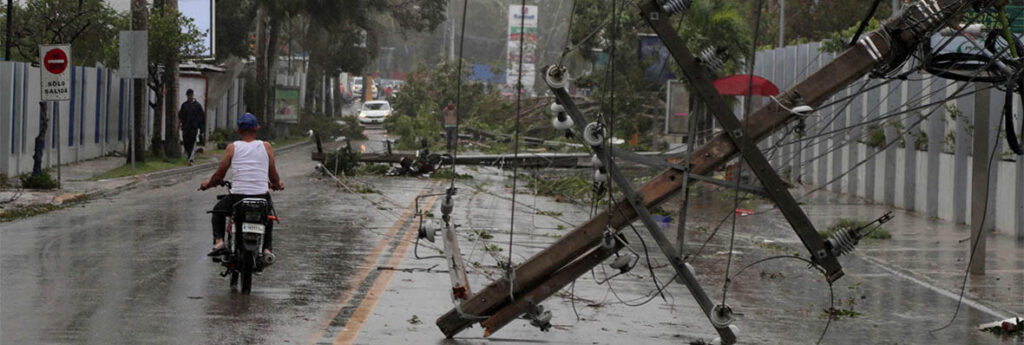Hurricane Fiona blasted the Turks and Caicos Islands on Tuesday as a Category 3 storm after devastating Puerto Rico, where most people remained without electricity or running water and rescuers used heavy equipment to lift survivors to safety.
The storm’s eye passed close to Grand Turk, the small British territory’s capital island, on Tuesday morning after the government imposed a curfew and urged people to flee flood-prone areas. Storm surge could raise water levels there by as much as 5 to 8 feet above normal, according to the U.S. National Hurricane Center.
Early Tuesday afternoon, the storm was centered about 30 miles (50 kilometers) north-northeast of North Caicos Island, with hurricane-force winds extending up to 30 miles (45 kilometers) from the center.
Premier Washington Misick urged people to evacuate. “Storms are unpredictable,” he said in a statement from London, where he had attended the funeral of Queen Elizabeth II. ”You must therefore take every precaution to ensure your safety.”
Fiona had maximum sustained winds of 115 mph (185 kph) and was moving north-northwest at 9 mph (15 kph), according to the Hurricane Center, which said the storm was likely to strengthen into a Category 4 hurricane as it approaches Bermuda on Friday.
Puerto Rico
Rain was still lashing parts of Puerto Rico Tuesday, where the sounds of people scraping, sweeping and spraying their homes and streets echoed across rural areas as historic floodwaters began to recede.
In the central mountain town of Cayey, where the Plato River burst its banks and the brown torrent of water consumed cars and homes, overturned dressers, beds and large refrigerators lay strewn in people’s yards Tuesday.
Drivers asked the National Guard if they could swing by their homes to help cut trees or clear clumps of mud and debris.
The cleanup efforts occurred on the fifth anniversary of Hurricane Maria, which hit as a Category 4 storm in 2017 and knocked out power for a year in parts of Cayey.
Gov. Pedro Pierluisi requested a major disaster declaration on Tuesday and said it would be at least a week before authorities have an estimate of the damage that Fiona caused.
He said the damage caused by the rain was “catastrophic,” especially in the island’s central, south and southeast regions.
“The impact caused by the hurricane has been devastating for many people,” he said.
The head of the Federal Emergency Management Agency travelled to Puerto Rico on Tuesday as the agency announced it was sending hundreds of additional personnel to boost local response efforts.
Parts of the island had received more than 25 inches (64 centimeters) of rain and more was falling Tuesday.
National Guard Brig. Gen. Narciso Cruz described the flooding as historic.
“There were communities that flooded in the storm that didn’t flood under Maria,” he said, referring to the 2017 hurricane that caused nearly 3,000 deaths. ”I’ve never seen anything like this.”
Cruz said 670 people have been rescued in Puerto Rico, including 19 people at a retirement home in Cayey that was in danger of collapsing.
“The rivers broke their banks and blanketed communities,” he said.
Some people were rescued via kayaks and boats while others nestled into the massive shovel of a digger and were lifted to higher ground.
He lamented that some people initially refused to leave their homes, adding that he understood why.
“It’s human nature,” he said. “But when they saw their lives were in danger, they agreed to leave.”
The blow from Fiona was made more devastating because Puerto Rico has yet to recover from Hurricane Maria, which destroyed the power grid in 2017. Five years later, more than 3,000 homes on the island are still covered by blue tarps.
U.S. Senate Majority Leader Chuck Schumer said Tuesday he would push for the federal government to cover 100% of disaster response costs – instead of the usual 75% – as part of an emergency disaster declaration.
“We need to make sure this time, Puerto Rico has absolutely everything it needs, as soon as possible, for as long as they need it,” he said.
Authorities said Tuesday that at least 1,220 people and more than 70 pets remained in shelters across the island.
Fiona triggered a blackout when it hit Puerto Rico’s southwest corner on Sunday, the anniversary of Hurricane Hugo, which slammed into the island in 1989 as a Category 3 storm.
By Tuesday morning, authorities said they had restored power to more than 300,000 of the island’s 1.47 million customers. Puerto Rico’s governor warned it could take days before everyone has electricity.
Water service was cut to more than 760,000 customers – two thirds of the total on the island – because of turbid water at filtration plants or lack of power, officials said.
The Dominican Republic
In the Dominican Republic, authorities reported two deaths: a 68-year-old man hit by a falling tree and an 18-year-old girl who was struck by a falling electrical post while riding a motorcycle. The storm forced more than 1,550 people to seek safety in government shelters and left more than 406,500 homes without power.
The hurricane left several highways blocked, and a tourist pier in the town of Miches was badly damaged by high waves. At least four international airports were closed, officials said.
The Dominican president, Luis Abinader, said authorities would need several days to assess the storm’s effects.
Fiona previously battered the eastern Caribbean, killing one man in the French territory of Guadeloupe when floodwaters washed his home away, officials said.
Heading north
Fiona is forecast to weaken before running into easternmost Canada over the weekend. It is not expected to threaten the U.S. mainland.

